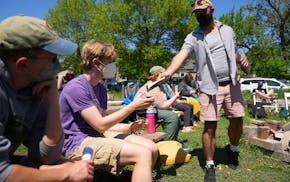Only a handful of fishing boats dotted Cruiser's Cove when Sgt. Bret Cline of the Hennepin County Water Patrol navigated the popular Lake Minnetonka party spot last week.
But he knows it will be a different scene over the July 4th weekend, when hot and sunny weather will bring scores of boaters to the bay for drinking and partying.
With 29 drownings already reported on Minnesota's lakes, rivers and pools this year, Cline and other water safety officials are bracing for the same possible deadly combination cited in many of those cases: hot weather, large gatherings and carelessness.
"When you're looking at the non-boating drownings, it's a wide age range of people who are becoming victims on the water, and it's a wide range of contributing factors," said Lisa Dugan, a boat and water safety coordinator with the Minnesota Department of Natural Resources. She attributes the increase in drownings to more people being out on the water. An unseasonably hot start to the summer and relaxed limits on group gatherings caused many Minnesotans — especially families — to flock to lakes and rivers.
More people have drowned in Minnesota so far this year than in the same time frame for each of the past nine years, according to preliminary data from the Minnesota DNR and numbers tracked by the Star Tribune. Across the state, 10 of the 29 drownings involved boats; the other 19 were non-boat-related drownings. Eighteen people drowned just in the month of June.
In Hennepin County alone, nine people have drowned already in 2021 compared with 16 in all of 2020, according to data from the Sheriff's Office. County officials and the DNR haven't been able to identify any patterns among the drowning victims. "It's just so random," Cline said.
As many people head for the water this weekend, Cline and the rest of the Water Patrol know the chances for emergencies increase dramatically.
Lake Minnetonka has already seen two fatalities leading up to the holiday weekend. A young person was killed Wednesday after two personal watercraft collided; it has not been determined if the crash or drowning was the cause of death. On Thursday evening, an unidentified adult male swimmer went underwater and never resurfaced. Authorities pulled him out and found him unresponsive.
The Water Patrol, which oversees safety and law enforcement on the county's 104 named lakes and three rivers, already has a robust safety plan in place for the holiday weekend. It has worked with local marinas to ensure ambulance access if needed, and its own public safety dock across from Cruiser's Cove will have ambulances on standby.
Intoxicated boaters will be the main concern for law enforcement this weekend. In 2020, nine of the 16 boating fatalities in Minnesota involved alcohol, up from the six-year average of 44%, the DNR said. Agencies across the state, including the DNR, State Patrol and county sheriff's offices, are increasing patrols for intoxicated boaters over the holiday weekend as part of the nationwide Operation Dry Water campaign.
"We don't want to arrest people, but we certainly want to keep the boating public safe. And in some cases, that means taking the dangerous ones off the water," said Lt. Adam Block with the DNR.
Emergency physicians and trauma specialists at Hennepin Healthcare have expressed alarm at the high number of drowning victims this year, especially children. Five children between the ages of 2 and 12 died over the course of eight days in June, according to the Star Tribune's count.
"The water is obviously inviting and it doesn't look scary to kids," said Dr. Ashley Bjorklund, medical director of pediatric critical care at Hennepin Healthcare.
Bjorklund said it's crucial that adults constantly supervise children near water. Especially during large gatherings, an adult "watcher" free of distractions should always have eyes on the swimmers.
People can drown quickly and often silently, Bjorklund said, which makes it even more important to closely supervise children. Drowning people won't flail their arms and holler for help. "We've got a very finite amount of time to get there, unfortunately, and we really almost need to be on scene to try to save somebody," said Capt. Shane Magnuson of the Hennepin County Sheriff's Office.
Lakes and rivers pose extra challenges. It's harder to see the bottom due to the murkier water, which could mask sudden drops or sharp rocks. In one spot the water could be 4 feet deep, but take two steps to the right and it could be 20 feet deep.
"If people don't know where they're at, they could easily, literally, get over their heads quite quickly," Magnuson said.
Once you find footing, the ground might not be solid or it could be covered with weeds that entrap your feet and legs. People have drowned after getting tangled in weeds, Magnuson said. Lakes and rivers can also have currents that pull swimmers away from the shores and shallower areas. Even strong swimmers can drown if they're not used to open water.
Open-water swimming is riskier for children than swimming in a pool. More children and teenagers drown in open water than in pools, according to a 2018 report from Safe Kids Worldwide, a nonprofit organization committed to preventing childhood injuries. Of those open-water drownings, nearly eight in 10 are male children and teen boys, the report found.
Nevertheless, Cline and Dugan agree that many drownings are preventable, as long as people follow safety guidelines.
"We all have our prep and pack list for the day going out to the water, so make sure safety is included on that every single time you go out," Dugan said.

Want to share info with the Star Tribune? How to do it securely

'Safe recovery sites' would offer syringes, naloxone and more to people using drugs. The plan could be in peril.
New Minnesota GOP leaders seek peace with party's anti-establishment wing

Who is Republican Lisa Demuth, Minnesota's first House speaker of color?

